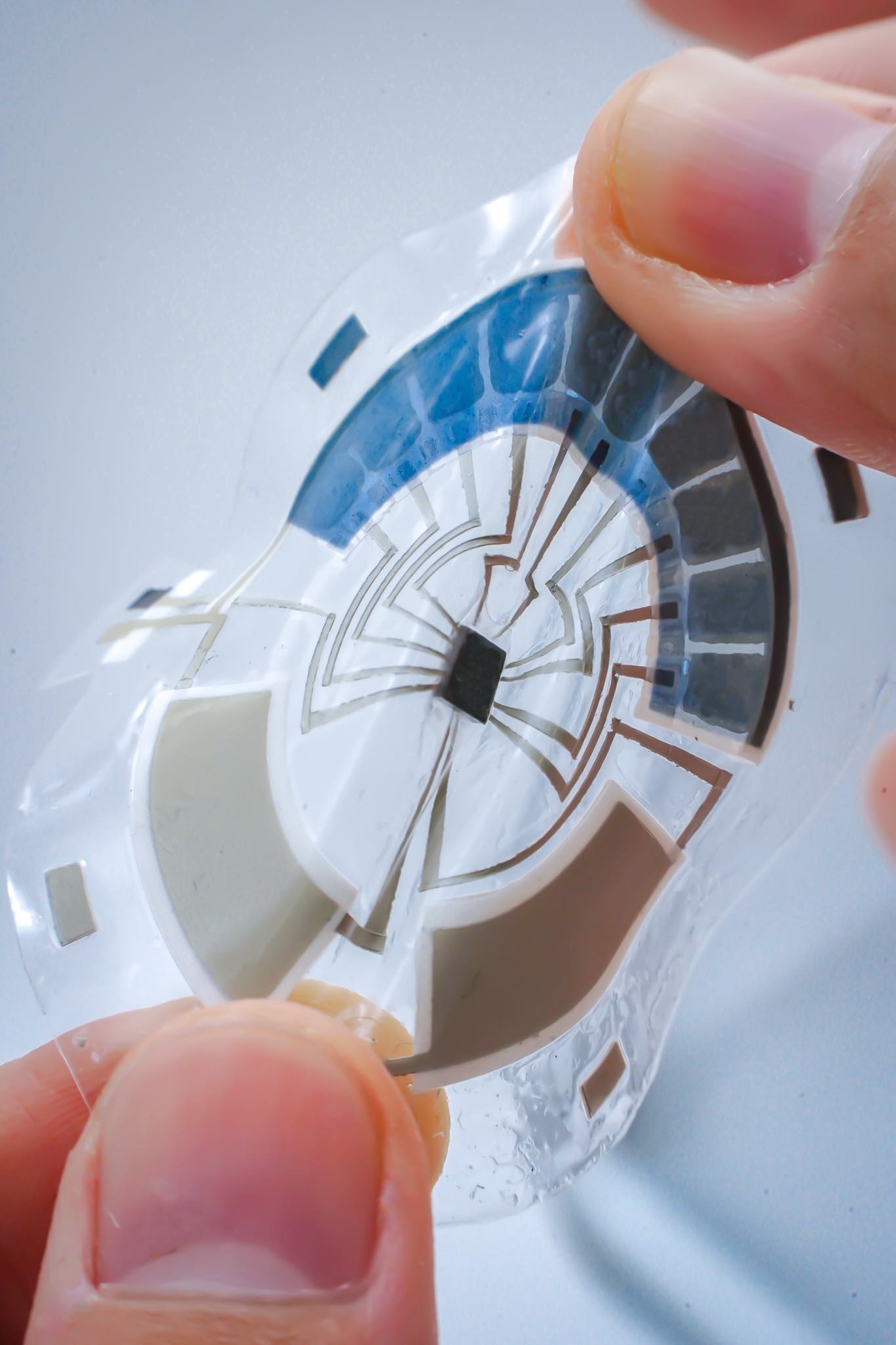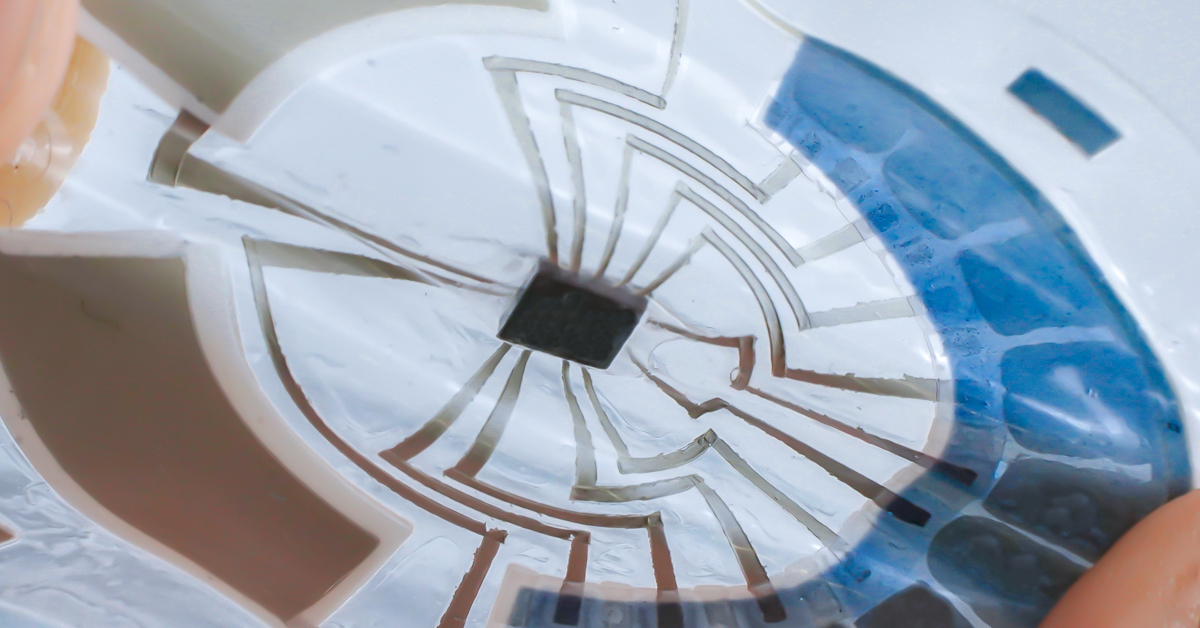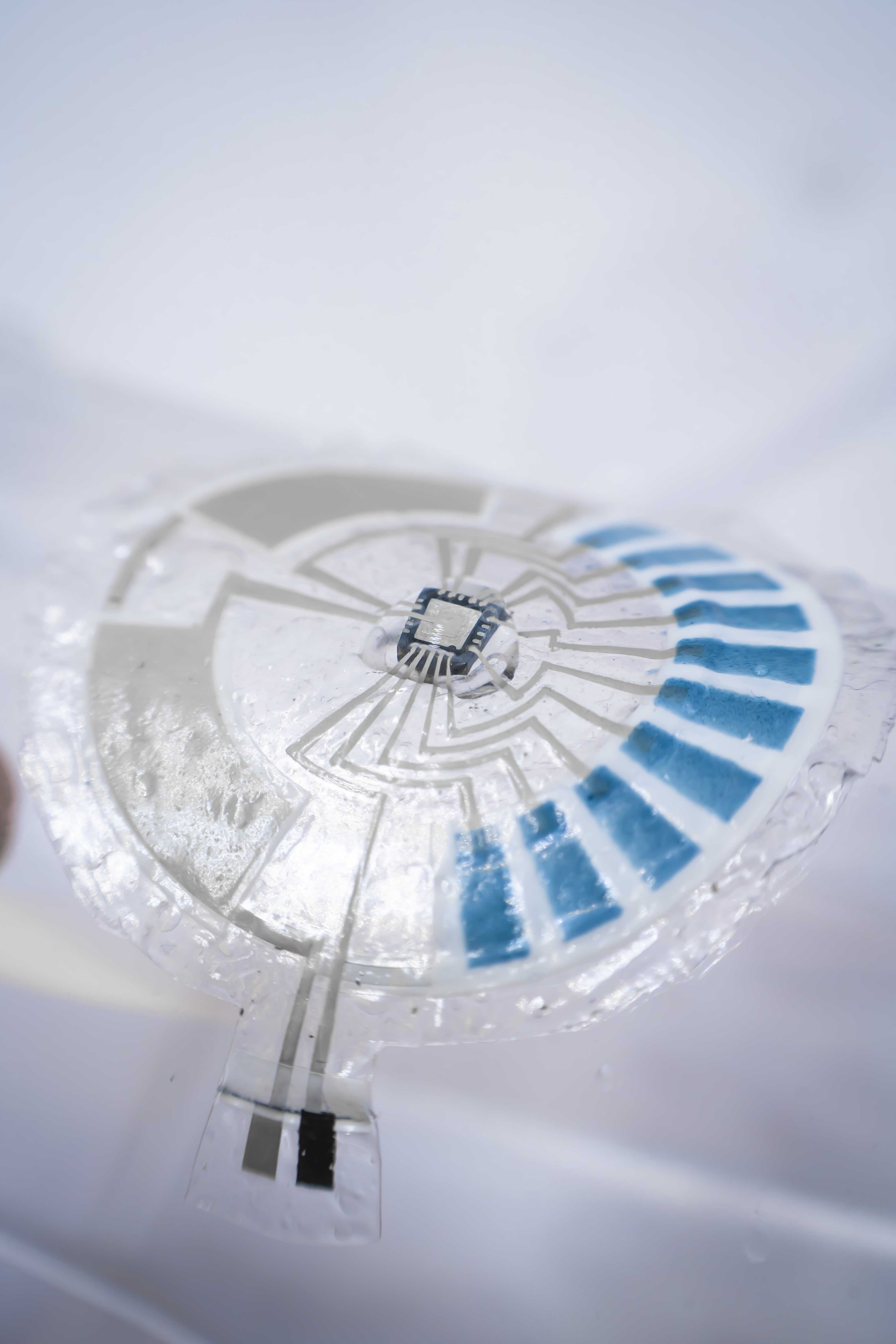创新背景
研究人员正试图解决可穿戴技术的实用性问题,很多可穿戴传感器的发明非常新颖,但实用性有限。
创新过程
这个小圆盘形贴片的独特设计包含了可穿戴传感器所需的所有基本组件:两个集成电池、一个微控制器、传感器、电路和一个可拉伸显示器。这涵盖了操作可穿戴传感器的所有必要功能,从充电到向用户显示结果。

贴片可以反复拉伸 20%,而不会影响其性能。
除了微控制器之外,所有的组件和互连都是使用定制的弹性油墨制作的,可以使用低成本和高通量的丝网印刷在可拉伸的聚合物薄片上。
该设备的制造涉及9种不同类型的可拉伸墨水的配方,这些墨水用于打印电池、电路、显示面板和传感器。该装置被一层一层地打印在可拉伸的聚合物薄片上,然后与水凝胶和微控制器芯片组装成完整的装置。每一种油墨都经过优化,以确保其与其他层的兼容性,同时平衡其电气、化学和机械性能。
在这项研究中,研究人员对系统的每个组件进行了压力测试,确保显示器、传感器和电池可以在1500次循环中拉伸20%,而对它们的性能几乎没有影响。电池也有足够的电量,以确保该补丁可以持续一周不间断使用。

为了展示这种贴片的广泛应用可能性,研究人员演示了四种与该贴片工作的不同类型的传感器:钠传感器、pH传感器、乳酸传感器和葡萄糖传感器。每种类型的传感器在运动过程中测量不同的汗液指标。
添加柔性显示器和可拉伸电池对实际表皮微尺度传感平台产生了巨大的影响。研究团队还安装了一个由粘合剂制成的流体通道,将贴片粘附在皮肤上,引导汗液流经传感器。贴片上有一个小型开关机构,只要用户按下开关,所测化学物质的浓度就会立即显示在显示屏上。
可穿戴屏幕上的快速可视化
为了将来自传感器的数据可视化,研究人员设计了一种特殊类型的非发光显示器,称为电致变色显示器。电致变色显示技术使用在施加电脉冲时变色的材料,功耗非常低。
典型的电致变色显示器需要透明的玻璃板,带有导电但易碎的涂层,这不适用于新设备。相反,研究人员转向一种名为PEDOT:PSS的特殊聚合物,它既导电又具有电致变色性能。当施加负电压时,聚合物由浅天蓝色变为深海军蓝,而当施加正电压时,聚合物又变为深蓝色。通过使用PEDOT:PSS调整油墨配方,可以使其既可打印又可拉伸。

显示屏可以快速改变颜色,以可视化汗液乳酸浓度。
研究人员设计了一个由10个独立像素组成的显示面板,通过打开不同像素的数字来显示化学物质的浓度。在优化了显示屏的运行条件后,每个像素都可以可逆的打开和关闭超过10,000个循环,足够它一周的运行。这些像素只需要500毫秒就能改变颜色,在此期间,它们平均消耗80微瓦的电力。由于它不需要电力来维持显示的结果,显示器是非常节能的应用。
目前,该贴片是不可充电的,一次只能使用一个传感器。该团队的目标是开发一种更先进的集成传感器,它可以充电,甚至可以从身体收集能量,以延长可穿戴贴片的寿命。皮肤佩戴的多路传感器,同时测量多种生物标记物,也可以添加到系统中,以提供用户生理状态的全面视图。
创新关键点
为了将来自传感器的数据可视化,研究人员设计了一种特殊类型的非发光显示器,称为电致变色显示器。电致变色显示技术使用在施加电脉冲时变色的材料,功耗非常低。
创新价值
这是第一个独立的可穿戴设备,它允许传感器独立运行并且不与外部设备进行任何有线或无线连接,直接可视化测量结果。
Innovative development of independent sweat sensors to measure multiple biomarkers
The unique design of the small disc-shaped patch contains all the basic components needed for a wearable sensor: two integrated batteries, a microcontroller, sensors, circuits, and a stretchable display. This covers all the functions necessary to operate the wearable sensor, from charging to displaying results to the user.
With the exception of the microcontroller, all components and interconnections are fabricated using custom elastic inks that can be printed on stretchable polymer sheets using low cost and high throughput screen printing.
The manufacturing of the device involves the formulation of nine different types of stretchable inks, which are used to print batteries, circuits, display panels and sensors. The device is printed layer by layer on a stretchable polymer sheet and then assembled with a hydrogel and microcontroller chip into a complete device. Each ink is optimized to ensure its compatibility with other layers while balancing its electrical, chemical and mechanical properties.
In the study, the researchers stress-tested each component of the system, ensuring that the display, sensors and batteries could be stretched by 20 percent over 1,500 cycles with little impact on their performance. The battery also has enough charge to ensure the patch can last up to a week of uninterrupted use.
To demonstrate the widespread possibilities of the patch, the researchers demonstrated four different types of sensors that work with the patch: a sodium sensor, a pH sensor, a lactic acid sensor and a glucose sensor. Each type of sensor measures different perspiration indicators during movement.
The addition of flexible displays and stretchable batteries makes a huge difference to the actual skin micro-scale sensing platform. The team also installed a fluid channel made of adhesive to attach the patch to the skin and direct sweat through the sensor. The patch has a small switch mechanism, and when the user presses the switch, the concentration of the measured chemical is immediately displayed on the screen.
Fast visualization on a wearable screen
To visualize the data from the sensors, the researchers designed a special type of non-light-emitting display called an electrochromic display. Electrochromic display technology uses materials that change color when an electrical pulse is applied, with very low power consumption.
Typical electrochromic displays require a clear glass plate with a conductive but fragile coating, which is not suitable for new devices. Instead, the researchers turned to a special polymer called PEDOT:PSS, which conducts electricity and has electrochromic properties. When a negative voltage is applied, the polymer changes from a light sky blue to a deep navy blue, and when a positive voltage is applied, the polymer turns dark blue again. By adjusting the ink formula using PEDOT:PSS, we can make it both printable and stretchable.
The researchers designed a display panel made up of 10 individual pixels to show the concentration of chemicals by turning on the numbers in different pixels. After optimizing the operating conditions of the display, each pixel can be turned on and off reversibly for more than 10,000 cycles, enough to run it for a week. The pixels take just 500 milliseconds to change color, during which time they consume an average of 80 microwatts of power. Since it does not require electricity to maintain the results of the display, the display is very energy efficient for applications.
Currently, the patch is non-rechargeable and can only use one sensor at a time. The team aims to develop a more advanced integrated sensor that can be charged and even collect energy from the body to extend the life of the wearable patch. Skin-worn multiplex sensors, which simultaneously measure multiple biomarkers, can also be added to the system to provide a comprehensive view of the user's physiological state.
智能推荐
电子科学创新思维 | 2022年CES国际消费电子产品展(1)
2022-09-07涉及学科涉及领域研究方向传感器技术创新思维 | 创新利用乙烯切割机制造可穿戴传感器
2022-11-09加州大学伯克利分校的工程师开发了一种制造可穿戴传感器的新技术,使医学研究人员能够以比现有方法更快的速度和更低的成本对新设计进行原型测试。
涉及学科涉及领域研究方向传感器创新思维 | 创新开发“电子皮肤”可监测人体健康
2022-10-25研究人员开发了一种电子皮肤,或称e-skin,可以直接应用在真实皮肤上。
涉及学科涉及领域研究方向太赫兹技术创新思维 | 创新开发低成本新型“相机”可高灵敏度地检测太赫兹脉冲
2022-11-07研究人员开发了一种新型“相机”,可以在室温和高压下快速、高灵敏度地检测太赫兹脉冲。
涉及学科涉及领域研究方向